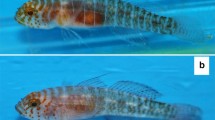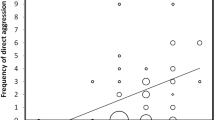Abstract
In this study, responses to the formation of social groups were compared between adult male and female Papio cynocephalus anubis. Quantitative behavioral data based on systematic focal animal sampling were used to test the hypothesis that adult male and female olive baboons are similar in their behavioral response to (1) the formation of monosexual social groups and (2) the simultaneous reduction of social unit and habitat size. Males and females differed (ttest, p <0.05) in performance of sexual, tension, and stereotypy behavior during large group formations. During small group formations, males and females differed in play, subordinate, locomotion, manipulation, sexual, tension, and stereotypy behavior. Our observations, clearly indicate that in captivity, under conditions of identical housing, social structure, and social unit history, males and females differ in their behavior performance. Our data suggest that some socioenvironmental conditions, such as the lack of heterosexual grouping, may exaggerate those differences.
Similar content being viewed by others
References
Altmann, S., and Altmann, J. (1970).Baboon Ecology African Field Research, Univ. of Chicago Press, Chicago.
Bramblett, C. A. (1976).Patterns of Primate Behavior Mayfield, Palo Alto.
Coelho, A. M., Jr., and Bramblett, C. A. (in preparation). Behavior of the genusPapio: Standardization of an ethogram, behavioral taxonomy, methods and baseline data.
Coelho, A. M., Jr., Bramblett, C. A., and McGill, H. C., Jr. (1978). Diet and serum lipid responses of seven species of cercopithecus monkeys: A preliminary study.Primates 19: 795–800.
Coelho, A. M., Jr., Bramblett, C. A., Quck, L. B., and Bramblett, S. S. (1976). Resource availability and population density in primates: A socio-bioenergetic analysis of the energy budgets of Guatemalan howler and spider monkeys.Primates 17: 63–80.
Elton, R. H., and Anderson, B. V. (1977). The social behavior of a group of baboons (Papio anubis) under artificaial crowding.Primates 18: 225–234.
Hunter, J. (1978). Guardian behavior in the sooty mangabeyCercocebusatys.Am. J. Phys. Anthropol. 48: 407.
Kummer, H., and Kurt, F. (1965). A comparison of social behavior in captive and wild hamadryas baboons. In Vagtborg, H. (ed.),The Baboon in Medical Research, Vol. I, Univ. of Texas Press, Austin, pp. 65–80.
Liozos, C. (1967). Play behavior in higher primates: A review. In Morris, D. (ed.),Primate Ethology Morrison and Gibb, London and Edinburgh, pp. 176–218.
Nie, N., Hull, C. H., Jenkins, J. G., Steinbrenner, K., and Bent, D. (1975).SPSS: Statistical Package for the Social Sciences McGraw-Hill, New York.
Rowell, T. (1967). A quantitative comparison of the behavior of a wild and caged baboon group.Anim. Behav. 15: 499–509.
Author information
Authors and Affiliations
Rights and permissions
About this article
Cite this article
Coelho, A.M., Bramblett, C.A. Sexual dimorphism in the activity of olive baboons (Papio cynocephalus anubis) housed in monosexual groups. Arch Sex Behav 10, 79–91 (1981). https://doi.org/10.1007/BF01542676
Issue Date:
DOI: https://doi.org/10.1007/BF01542676




